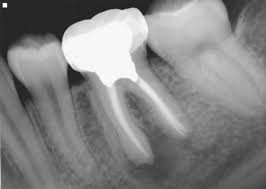What to Expect From a Root Canal
What is a root canal and when is it
needed?
A root canal treatment means removing infection, inflammation, and, an unhealthy nerve, from inside the root of the tooth. After thoroughly cleaning the root, a soft filling is placed inside the root to prevent future new infections.
Here are the three main reasons for receiving root canal treatment:
Infection has spread into the nerve inside the root of the tooth, usually as a result of a deep cavity.
The presence of inflammation (swelling) in the nerve inside the root due to a deepening cavity, or at times, resulting from trauma, such as a fall.
For very broken teeth, even if the nerve is healthy, a root canal treatment may be necessary in order to place a post into the root which is sometime needed to hold a crown.
Notice the two white lines in the roots. That is the soft roof canal filling which replaces a damaged or infected nerve.
Cavities and root canals
As a cavity grows, if left untreated, it will eventually reach the nerve inside the tooth and then bacteria will spread into the nerve. A dentist must remove the infected nerve from inside the root by using very thin cleaning instruments (see image below). The longer time an infection is present in a tooth, the greater is the chance that the root canal treatment will not succeed.
A root canal that doesn’t work out
A ‘failing’ root canal means infection is regrowing after a root canal is done and has spread throughout the tooth and into the bone underneath the tooth. This may result in gum, or face, swelling. Sometimes redoing the root canal will cure the infection, but, often the tooth has to be removed.
Swellings associated with root canals
If a large swelling of the gums or face occurs, whether before, during, or after a root canal, the dentist must drain puss from the swelling immediately. Oral antibiotics must also be given to take at home. A slight swelling appearing after root canal therapy is a common occurrence and often heals on its own without further treatment.
Does a root canal need a crown?
After completion of the root canal, it is not always necessary to place a post or a crown. Many root canal treated teeth can be restored with a simple filling. Talk to your dentist about this.
Number of visits in a root canal
The good news about root canal is that they usually last for years. The number of visits necessary to complete a root canal depends on the difficulty of the root canal and on the amount of pain the patient may experience after each visit. If there is pain, it is sometimes necessary to add more visits to ensure patient comfort. Root canal treatment takes anywhere from one to three visits on average. For many teeth, pain can be relieved after the first visit, however, pain felt after each root canal visit can vary widely so be prepared and ask for pain relieving medication. If pain after a root canal persists for more than three days, consult your dentist - an incision might be necessary in the gum to relieve the discomfort.
Here are the steps to complete a root canal treatment
These thin files are used to clean out a damaged nerve. They are quick, relatively pain free and efficient. Root canal is not something to fear.
If there is a swelling present, then healing the swelling is the first order of business. All swellings are dental emergencies, and some swellings, such as near the nose or below the jaw, are of greatest concern and carry the risk of hospitalization!
Once a swelling is gone, then the root canal will be started. Only local anesthesia (a shot) is needed and the amount of discomfort experienced in the initial drilling stages of a root canal is not very great. You should not walk into a dental office with excessive fear about it.
The next step is for the dentist to use very thin files (see image) either held in the fingers or rotating in a dental drill, to clean the infected or inflamed nerve out of the roots.
Lastly, the roots are completely filled. The filling material is generally a soft paste (known as ‘gutta percha’) which may also contain a thin pin for strength made from stainless steel, titanium or plastic. The tooth is then completed with a filling or crown.


